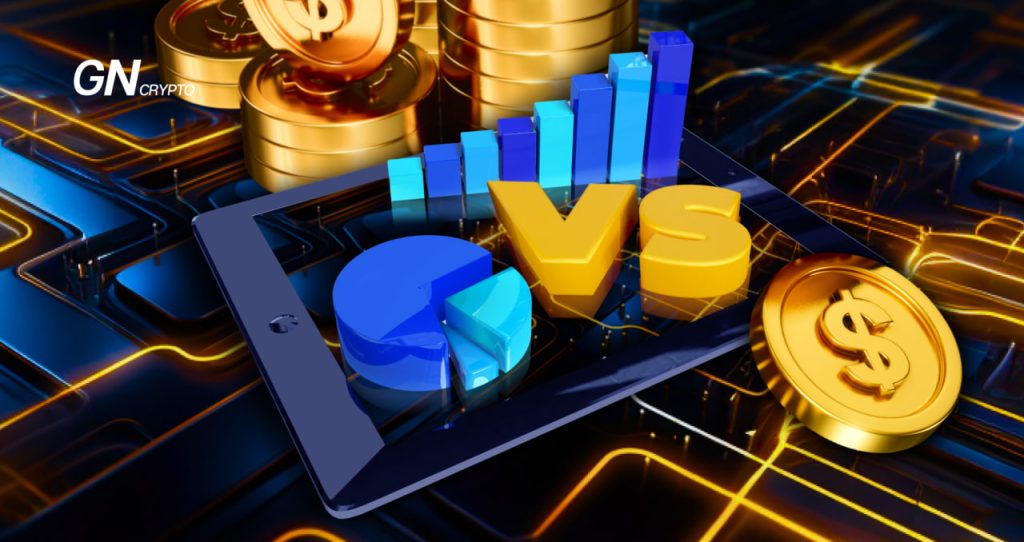Fundamental vs. Technical Analysis

Refining your trading skills in the diverse financial markets requires a deep understanding of distinct analytical strategies. The question is, which is more effective – fundamental or technical analysis?
On this page
The asset valuation features two prominent and respected strategies: fundamental and technical analysis. These approaches have been the subject of ongoing debate, with experts divided on their relative strengths and weaknesses.
This article offers a clear, comprehensive guide, immersing you in the world of fundamental and technical analysis. You’ll be introduced to the foundational elements and tools unique to each method, aiding you in identifying the approach that best aligns with your trading style and goals.
What is Fundamental Analysis?
The Core of Fundamental Analysis. Source: vecteezy.com
Fundamental analysis is a thorough, holistic approach used to assess the intrinsic value of an asset. It focuses on the economic indicators of an issuer and the industry, encompassing an in-depth review of corporate financial statements, examination of inflation rates, and assessment of overall market sentiment.
Particularly favored for medium to long-term investment strategies, fundamental analysis empowers traders to discern the true value of an asset. It enables an evaluation of whether the current market price is an accurate reflection of the asset's intrinsic worth, identifying potential overvaluation or undervaluation.
Key Tools in Fundamental Analysis:
- Financial Reports: These encompass crucial data on a company’s capital, cash flow, income, and expenses, providing a comprehensive view of a company's financial standing.
- Macroeconomic Indicators: Analysts examine inflation rates, unemployment statistics, and GDP growth to glean insights about the overall economic conditions affecting a company, as well as to predict consumer behaviors.
- Market News: News can significantly sway asset values. Positive developments often boost asset prices, whereas negative news can trigger a decline. For instance, the collapse of the centralized exchange FTX resulted in a 28% drop in its FTT token. Conversely, rumors of a potential relaunch led to a 311% surge in the asset’s value.
In cryptocurrency markets, fundamental analysis not only involves general factors but also niche-specific ones such as off-chain and on-chain metrics, and project-specific indicators.
Criteria for Fundamental Analysis in the Crypto Market:
- Project Team: Analyzing the top management’s reputation and past experiences offers insights into the project's potential. This information is typically found on the company's website, with LinkedIn serving as a valuable resource.
- Investments: The amount and quality of investments a project attracts are indicative of its potential success. Traders consider investor tiers (Tier 1, Tier 2, Tier 3), with resources like CryptoRank and Crunchbase providing detailed insights.
- Social Media Presence: The size and activity level of a project’s social media following can indicate its popularity and market traction. Analysts often assess follower counts on platforms like X (formerly Twitter) and use evaluation tools like TwitterScore.
- Whitepaper: This fundamental document outlines the project’s technical aspects, operational mechanics, and interaction rules, serving as a blueprint of the project's vision and functionality.
- Tokenomics: This refers to the token’s economic model, encompassing its utility, distribution mechanisms, and features like token burning (the periodic elimination of certain amounts of tokens to manage supply).
- Roadmap: A detailed implementation plan outlining the project’s phases and specific milestones. Some analysts use platforms like GitHub to monitor project updates.
Fundamental analysis is ideal for evaluating long-term prospects, requiring an understanding of the industry, the ability to process extensive information, and patience.
The big money is not in the buying and the selling but in the waiting,
says Charlie Munger.
What is Technical Analysis?
Graphical Patterns of Technical Analysis. Source: finbold.com
Technical analysis is an alternative method for asset valuation, focusing on historical performance indicators. It involves using indicators, patterns, and statistical analyses, suitable for day trading and swing trading.
Key Tools in Technical Analysis:
- Indicators: Classified into trend, momentum, volume, and volatility indicators, these tools help identify potential levels, trend changes, and overbought or oversold conditions (e.g., ADX and RSI indicators).
- Graphical Patterns: Traders look for repeating candlestick formations like wedges, head and shoulders, or doji to predict price movements.
- Support and Resistance Levels: These critical chart levels indicate potential trend shifts – a breakthrough in support suggests a downward trend while overcoming resistance points to an upward trend.
- Fibonacci Levels: These horizontal lines, derived from the Fibonacci sequence, help identify potential support and resistance zones.
- Trend Lines: Drawn across pivot points in price movement, these lines help forecast the end of corrections and the resumption of trends.
Technical analysis varies in its applications and methods, with popular approaches including classical technical analysis, the Smart Money Concept, and the Wyckoff Method.
Traders using technical analysis believe in market cyclicity, applying past patterns to current market conditions.
Fundamental Analysis vs Technical Analysis: Which is Better?
A JABS study reveals that 85% of traders use both fundamental and technical analysis to predict price movements, as each method has its own strengths and weaknesses, suiting different trading scenarios.
If you're an intra-day trader adept at spotting chart patterns, technical analysis might suit you. Conversely, if you're a long-term investor skilled at handling extensive data and specializing in specific niches, fundamental analysis would be your preferred approach.
The content on The Coinomist is for informational purposes only and should not be interpreted as financial advice. While we strive to provide accurate and up-to-date information, we do not guarantee the accuracy, completeness, or reliability of any content. Neither we accept liability for any errors or omissions in the information provided or for any financial losses incurred as a result of relying on this information. Actions based on this content are at your own risk. Always do your own research and consult a professional. See our Terms, Privacy Policy, and Disclaimers for more details.




























